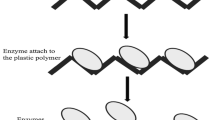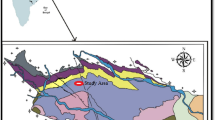Abstract
Analyses of the original and pyrolytic products of coccolithophore at various temperatures suggest that the contribution of coccolithophore to the formation of large immature oil reservoirs should attract keen interest. Through biochemical processes algae can change inorganic sulphur into organic sulphur, which could be one of the most important precursors of organic sulphur compounds in oil and source rocks. When Methylphenanthrene Index (MPI) and Methylphenanthrene Ratio (MPR) indices were used to evaluate the evolution degree of source rocks and oil maturity, other maturity indices must be used together for correction. In low maturity, the relative abundances of dibenzothiophene (DBT), fluorine (F) and dibenzofuran (DBF) can be used to identify the oxidation-reduction environments.
Similar content being viewed by others
References
Fernandez, E., Boyd, P., Holligan, P. M. et al., Production of organic and inorganic carbon within a large-scale coccolithophore bloom in the northeast Atlantic ocean, Mar. Ecol. Prog. Ser., 1993, 97: 271.
Teece, M. A., Getlift, J. M., Leftley, J. W. et al., Microbial degradation of the marine prymnesiophyteEmiliania huxleyi under oxic and anoxic conditions as a model for early diagenesis: long chain alkadienes, alkenones and alkyl alkenoates, Org. Geochem., 1998, 29(4): 863.
Song, Y., Li, S., Experimental study on simulating hydrocarbon-generation of coccolithophoridaes heating, I. Generation rate and property of hydrocarbons, characteristic of alkanes and alkenes, Geological Journal of Universities (in Chinese), 1995, 1: 95.
Wu, Q., Dai, J., Shiraiwa, Y. et al., A renewable energy sourcehydrocarbon gases resulting from pyrolysis of the marine nanoplanktonic algaEmiliania huxleyi, Journal of Applied Phycology, 1999, 11: 137.
Wu, Q., Shiraiwa, Y., Takeda, H. et al., Liquid-saturated hydrocarbons resulting from pyrolysis of the marine coccolithophoresEmiliania huxleyi andGephyrocapsa oceanica, Mar. Biotechnol., 1999, 1: 346.
Zhang, L., Zhang, C., The Basic Law of the Generation, Migration and Accumulation of Immature Oil (in Chinese), Bei**g: Geological Publishing House, 1999, 27–57.
Okaichi, T., Nishino, S., Imatomi, Y., Collection and Mass Culture of Toxic Phytoplankton—Occurrence, Mode of Action, and Toxin (ed. Society of Science of Fisheries), Tokyo: Kouseisha-Kouseikaku, 1982, 23–34.
Wang, R., Zhou, W., Dai, J. et al., Identification of long chain isoprenoid hydrocarbons from pyrolytic product ofDunaliella, Chinese Science Bulletin, 1999, 44(18): 1700.
Radke, M., Rullkotter, J., Vriend, S. P., Distribution of naphthalenes in crude oils from the Java Sea: Source and maturation effects, Geochim. Cosmochim., 1994, 58: 3675.
Killops, S. D., Novel aromatic hydrocarbons of probably bacterial origin in a Jurassic Lacustrine sequence, Org. Geochem., 1991, 17(1): 25.
Hou, D., Wang, T., Approach to Terrestrial Petroleum Geochemistry (in Chinese), Bei**g: China University of Geosciences Press, 1995, 25–31; 88–95.
Radke, M., Weite, D. H., Wilisch, H., Geochemical study on a well in the Western Canada Basin: relation of the aromatic distribution pattern to maturity of organic matter, Geochim. Cosmochim., 1981, 46: 1.
Wang, T., Zhong, N., Hou, D. et al., The Low Maturity Petroleum Formation Mechanism and Occurrence (in Chinese), Bei**g: Petroleum Industry Press, 1995, 52–62.
Sinninghe Damaste, J. S., Rupstra, W. I. C., de Leeuw, J. W. et al., The occurrence and identification of series of organic sulphur compounds in oils and sediment extracts, II. Their presence in samples from hypersaline and non-hypersaline palaeoenvironments and possible application as source, palaeoenvironments and maturity indicators, Geochim. Cosmochim., 1989, 53: 1323.
Sinninghe Damaste, J. S., Math, E. L. K., Brian, H., Origin of low-molecular-weight alkylthiophenes in pyrolysates of sulphurrich kerogens as revealed by micro-scale sealed vessel pyrolysis, Org. Geochem., 1998, 29(8): 1891.
Erdman, J. G., Some chemical aspects of petroleum genesis as revealed to the problem of source bed recognition, Geochem. Cosmochim. Acta, 1961, 22: 16.
Langworthy, D. N., Tornabene, T. G., Holzer, G., Lipids of archaebacteria, Zbl. Bakt. Hyg., 1982, 3: 228.
Author information
Authors and Affiliations
Corresponding author
About this article
Cite this article
Zhou, W., Wu, Q., Wang, R. et al. Distribution of aromatic biomarkers in pyrolysates of coccolithophore. Chin.Sci.Bull. 46, 246–252 (2001). https://doi.org/10.1007/BF03187179
Received:
Published:
Issue Date:
DOI: https://doi.org/10.1007/BF03187179




